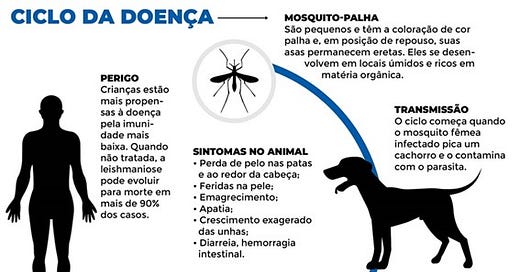Brazil: Leishmaniasis in Minas Gerais
National Week for the Control and Combat of Leishmaniasis took place from August 10 to 17
Last week was National Week for the Control and Combat of Leishmaniasis and the Government of Minas Gerais, through the State Health Department (SES-MG), reinforced to the entire population the importance of early diagnosis and treatment of the disease, available through the Unified Health System (SUS) throughout the state.
From the beginning of the year through August 7, 59 confirmed cases of visceral leishmaniasis (VL) were reported, nine of which resulted in death, and 490 cases of cutaneous leishmaniasis, with one death reported in the state.
According to the director of Surveillance of Communicable Diseases and Immunization at SES-MG, Marcela Lencine Ferraz, actions are carried out on an ongoing basis, in partnership with municipalities, aimed at all links in the disease transmission cycle.
“We work together with the Municipal Health Departments to identify where there is a higher incidence of the sandfly, which transmits leishmaniasis, and distribute supplies to control this vector, in addition to monitoring the disease in humans and animals, especially dogs, which are involved in the visceral leishmaniasis cycle,” he reports.
“We also work in an integrated manner to strengthen early diagnosis and timely treatment of the disease in humans, in order to prevent severity and death from leishmaniasis, which is our main objective,” highlights the director.
Caused by the parasite of the genus Leishmania , leishmaniasis is transmitted to humans through the bite of the female sand fly, a very small insect (two to three millimeters), light in color, almost transparent. For this reason, in some regions, it is popularly known as the sand fly.
Transmission occurs when infected females bite dogs or other infected animals, and then bite humans, transmitting the protozoan. Therefore, if the animal shows symptoms of leishmaniasis, the owner should immediately seek out the Zoonosis service or the Municipal Health Department and request a test to diagnose the disease.
There are several types of leishmaniasis, but the most common clinical presentations are visceral leishmaniasis (VL), which attacks the internal organs, mainly the spleen and liver, and cutaneous leishmaniasis, which attacks the skin and mucous membranes.
Visceral leishmaniasis is a chronic, non-contagious disease with high morbidity and significant mortality when left untreated. The main symptoms are long-lasting irregular fever (more than seven days), lack of appetite, weight loss, weakness, abdominal enlargement, anemia and bleeding in the most advanced stage of the disease.
“Visceral leishmaniasis is serious, but it can be treated in humans. Children, the elderly and immunocompromised individuals are at greatest risk. When left untreated, this disease has a mortality rate of over 90% of patients,” warns Ricardo Luiz Fontes Moreira, an infectious disease specialist at the Center for Strategic Information on Health Surveillance (Cievs Minas).
“Therefore, it is essential that the patient seeks care at a Basic Health Unit as soon as the first symptoms appear, especially persistent fever with an undefined cause. The doctor will request tests to confirm or deny the disease and, once diagnosed, the sooner treatment is started, the greater the chances of avoiding aggravations and complications”, he reiterates.
American cutaneous leishmaniasis affects the skin and mucous membranes and can present different clinical manifestations. Skin lesions can be single, multiple, disseminated or diffuse; and the mucosal form is characterized by the presence of destructive lesions generally located in the upper airways.
“Cutaneous leishmaniasis (CL) is mainly characterized by lesions that look like ulcers, which have a raised and firmer edge, and are not painful ulcers. They usually appear on exposed parts of the body, such as arms, legs and back, and can also appear in mucous membrane areas, such as the nose or mouth,” explains the infectious disease specialist.
“Despite the low risk of death, CL causes many problems, both in terms of clinical issues and psychological factors, due to the injuries and deformities it can cause,” explains the doctor.
In general, treatment of people affected by visceral leishmaniasis occurs in a hospital environment, because these patients are more debilitated.
“The medication is used for a specific period of time and the patient may have a quick initial recovery, but full recovery can take up to six months. Therefore, the person must be monitored on an outpatient basis until final recovery,” explains officials.
In the treatment of cutaneous leishmaniasis, most patients receive the medication at Basic Health Units and remain at home while they recover.
“Depending on the medication, the treatment for CL varies from 15 days to 40 days. However, in some cases, the lesion does not heal completely during this period and full healing can take up to six months,” he highlights.
There is no vaccine against human leishmaniasis. The most commonly used measures to prevent the disease are based on vector and reservoir control, individual protection, early diagnosis and treatment of patients, environmental management and health education.





